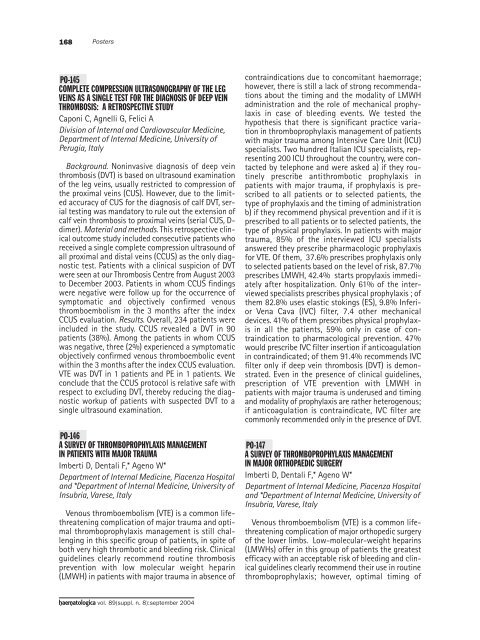Haematologica 2004;89: supplement no. 8 - Supplements ...
Haematologica 2004;89: supplement no. 8 - Supplements ...
Haematologica 2004;89: supplement no. 8 - Supplements ...
- No tags were found...
You also want an ePaper? Increase the reach of your titles
YUMPU automatically turns print PDFs into web optimized ePapers that Google loves.
168PostersPO-145COMPLETE COMPRESSION ULTRASONOGRAPHY OF THE LEGVEINS AS A SINGLE TEST FOR THE DIAGNOSIS OF DEEP VEINTHROMBOSIS: A RETROSPECTIVE STUDYCaponi C, Agnelli G, Felici ADivision of Internal and Cardiovascular Medicine,Department of Internal Medicine, University ofPerugia, ItalyBackground. Noninvasive diag<strong>no</strong>sis of deep veinthrombosis (DVT) is based on ultrasound examinatio<strong>no</strong>f the leg veins, usually restricted to compression ofthe proximal veins (CUS). However, due to the limitedaccuracy of CUS for the diag<strong>no</strong>sis of calf DVT, serialtesting was mandatory to rule out the extension ofcalf vein thrombosis to proximal veins (serial CUS, D-dimer). Material and methods. This retrospective clinicaloutcome study included consecutive patients whoreceived a single complete compression ultrasound ofall proximal and distal veins (CCUS) as the only diag<strong>no</strong>stictest. Patients with a clinical suspicion of DVTwere seen at our Thrombosis Centre from August 2003to December 2003. Patients in whom CCUS findingswere negative were follow up for the occurrence ofsymptomatic and objectively confirmed ve<strong>no</strong>usthromboembolism in the 3 months after the indexCCUS evaluation. Results. Overall, 234 patients wereincluded in the study. CCUS revealed a DVT in 90patients (38%). Among the patients in whom CCUSwas negative, three (2%) experienced a symptomaticobjectively confirmed ve<strong>no</strong>us thromboembolic eventwithin the 3 months after the index CCUS evaluation.VTE was DVT in 1 patients and PE in 1 patients. Weconclude that the CCUS protocol is relative safe withrespect to excluding DVT, thereby reducing the diag<strong>no</strong>sticworkup of patients with suspected DVT to asingle ultrasound examination.PO-146A SURVEY OF THROMBOPROPHYLAXIS MANAGEMENTIN PATIENTS WITH MAJOR TRAUMAImberti D, Dentali F,* Age<strong>no</strong> W*Department of Internal Medicine, Piacenza Hospitaland *Department of Internal Medicine, University ofInsubria, Varese, ItalyVe<strong>no</strong>us thromboembolism (VTE) is a common lifethreateningcomplication of major trauma and optimalthromboprophylaxis management is still challengingin this specific group of patients, in spite ofboth very high thrombotic and bleeding risk. Clinicalguidelines clearly recommend routine thrombosisprevention with low molecular weight heparin(LMWH) in patients with major trauma in absence ofcontraindications due to concomitant haemorrage;however, there is still a lack of strong recommendationsabout the timing and the modality of LMWHadministration and the role of mechanical prophylaxisin case of bleeding events. We tested thehypothesis that there is significant practice variationin thromboprophylaxis management of patientswith major trauma among Intensive Care Unit (ICU)specialists. Two hundred Italian ICU specialists, representing200 ICU throughout the country, were contactedby telephone and were asked a) if they routinelyprescribe antithrombotic prophylaxis inpatients with major trauma, if prophylaxis is prescribedto all patients or to selected patients, thetype of prophylaxis and the timing of administrationb) if they recommend physical prevention and if it isprescribed to all patients or to selected patients, thetype of physical prophylaxis. In patients with majortrauma, 85% of the interviewed ICU specialistsanswered they prescribe pharmacologic prophylaxisfor VTE. Of them, 37.6% prescribes prophylaxis onlyto selected patients based on the level of risk, 87.7%prescribes LMWH, 42.4% starts propylaxis immediatelyafter hospitalization. Only 61% of the interviewedspecialists prescribes physical prophylaxis ; ofthem 82.8% uses elastic stokings (ES), 9.8% InferiorVena Cava (IVC) filter, 7.4 other mechanicaldevices. 41% of them prescribes physical prophylaxisin all the patients, 59% only in case of contraindicationto pharmacological prevention. 47%would prescribe IVC filter insertion if anticoagulationin contraindicated; of them 91.4% recommends IVCfilter only if deep vein thrombosis (DVT) is demonstrated.Even in the presence of clinical guidelines,prescription of VTE prevention with LMWH inpatients with major trauma is underused and timingand modality of prophylaxis are rather heteroge<strong>no</strong>us;if anticoagulation is contraindicate, IVC filter arecommonly recommended only in the presence of DVT.PO-147A SURVEY OF THROMBOPROPHYLAXIS MANAGEMENTIN MAJOR ORTHOPAEDIC SURGERYImberti D, Dentali F,* Age<strong>no</strong> W*Department of Internal Medicine, Piacenza Hospitaland *Department of Internal Medicine, University ofInsubria, Varese, ItalyVe<strong>no</strong>us thromboembolism (VTE) is a common lifethreateningcomplication of major orthopedic surgeryof the lower limbs. Low-molecular-weight heparins(LMWHs) offer in this group of patients the greatestefficacy with an acceptable risk of bleeding and clinicalguidelines clearly recommend their use in routinethromboprophylaxis; however, optimal timing ofhaematologica vol. <strong>89</strong>(suppl. n. 8):september <strong>2004</strong>
















